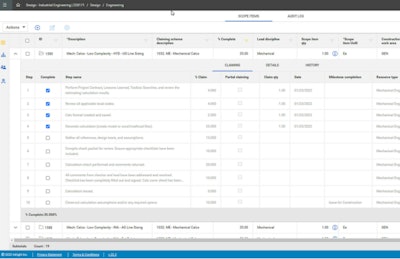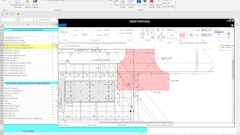
Scottsdale, Ariz.-based project and program management software vendor InEight today announced the launch of InEight Design, which delivers integrated project controls for professional services engineering and architecture scopes.
InEight Design provides the traceability of design quantities as required under alternative delivery projects like design build or engineer, procure, construct (EPC).
The new InEight module launches after a pilot on more than $14 billion of design-build and alternative delivery work. According to the company, the software helped reduce design quantity growth risk by up to 20 percent and reducing engineering costs by 10 percent.
The resulting product, InEight Design, helps engineering and design teams control their scopes, manage resources, predict completion dates, track progress, and perform earned value management (EVM) as the design work proceeds through 30-60-90-issued for construction (IFC) milestones.
Extending Project Cost Management
With InEight Design, the company is on one hand revisiting its origins even as it extends its construction project management software offering to a new demographic.
“InEight started 30 years ago,” InEight Chief Product Officer Brad Barth told ForConstructionPros in a debriefing call the day before the announcement. “Our focus was originally on project cost management—estimating, budgeting and forecasting, specifically for construction. But as you start to automate estimates, budgets and forecasts, that data has connections out to adjacent things. The same assumptions that go into estimates go into work plans and procurement plans—it becomes part of planning. Then, we need to track as-builts, progress, percent complete and earned values. So today the software has grown from project cost management to bridge the gap between the expectations for the outcomes and realities. Whether our customers are owners or contractors—they can use InEight software to plan the project and then control those things in three dimensions—progress against budget, delivery of the scope and then quality and commissioning. They can look back after the fact and determine what lessons are to be learned, and what risks did we miss?"
According to Barth, the new module came in large part from a demand perceived among the InEight customer base, many of whom are large generals, owners or EPC contractors with internal design teams. These engineers and designers are often operating on a shared risk model with
“Most of our customers are owners or contractors—with a trend towards more iterative contracting—design build, integrated project delivery where there is overlap between design and construction processes,” Barth said. “We have gotten more pull over to the designers, and for good reason. Imagine you are a design firm, participating in a design-build project or maybe you are a design entity inside an EPC. On the design portion of the project, they need to identify the design scope, manage design resources and make sure they have the right people assigned to the work. They need to track progress on that design work—often at 30, 60 and 90 percent completion intervals. Our design customers may still take projects where design and construction are handled separately, and with a stand-alone design model the need for this project functionality may be even greater. But this functionality was born in that internally connected approach where you need to make your design and your build into more than the sum of the parts.”
 InEight Design delivers project controls to construction design projects. It is particularly well-suited to iterative design processes like design build and engineer-procure-construct (EPC).InEight
InEight Design delivers project controls to construction design projects. It is particularly well-suited to iterative design processes like design build and engineer-procure-construct (EPC).InEight
New Functionality in Construction Software Suite
InEight Design becomes a net new sales part module, joining modules for:
- Estimating and project cost management
- Document management
- Connected analytics
- Capital and contract management
- Field execution management
- Safety, quality and commissioning
- Virtual design and construction
While InEight Design can deliver value as a stand-alone solution, according to Barth “the real benefit is that it interplays with all the other InEight solutions. So, this new InEight Design product helps you manage that design work, but it is also creating documentation that needs to be routed through a high level design or detailed design review process, and that for instance happens in our document management solution.”
This high degree of integration internal to the InEight solution is complemented by external integrations with enterprise resource planning (ERP), design, collaboration and other types of software. But these are more a factor for the rest of the InEight suite, more than the new InEight Design.
“The nice thing about the design work is there is not a lot of integration with external systems,” Barth said. “You are managing design quantities and percent complete, but the integration is more with other InEight applications that tie back over to our budget management and construction work planning systems so your work plans can be updated based on your design quantities.”
Pricing and Market
The InEight product suite rests on the Microsoft Azure cloud and is available through a multi-tenant software-as-a-service (SaaS) subscription or as a single-tenant solution under a special enterprise-level agreement.
The InEight product team ships updates every nine weeks, and customers can preview each update in a test environment before they go into production. In the multi-tenant environment where every customer is running the same instance of the software and internal software conflicts are not likely to result from an update. But some customers may have custom integrations with other systems and may want to ensure that integration does not break with the new update.
Single-tenant customers can pick and choose more freely what updates and new versions to adopt but are still often on one of the last couple releases, according to Barth.
InEight uses a per-module, per-user pricing model. Situations where there are multiple user types, some of whom will be heavier software users than others paired changing numbers of users may be a fit for enterprise all-you-can-eat pricing.
“The thing to remember about our pricing is that some of our competitors base their pricing on annual volume—so as you win more work and do more work, the software company gets more money,” Barth said. “We don’t do that—we want to be predictable.”
The InEight Design module is a fit for engineering or design firms with about $25 million in revenue or more. Construction contractors who are a good fit for InEight typically have more than $50 million in annual construction volume. But what is more important than company revenue is project size.
“You can control a smaller project on a sophisticated spreadsheet,” Barth said. “But that large, multi-year project with multiple collaborators and stakeholders benefits from something like InEight.”





























